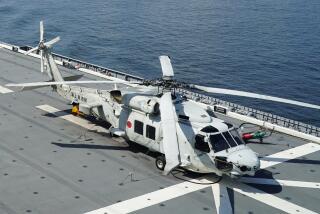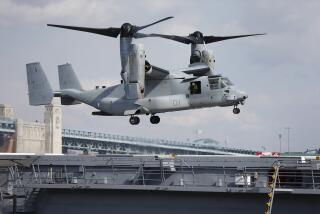Navy Brass Raise Safety, Seamanship Issues
- Share via
WASHINGTON — The collision last week of the U.S. submarine Greeneville and a Japanese fishing boat is the latest in a string of major accidents that has raised concern among Navy leaders about training and seamanship in the fleet.
Navy ships have been involved in 13 serious mishaps since October 1999. Last September, Adm. Vern Clark, the chief of naval operations, ordered the fleet to take a one-day “safety stand-down” to review procedures.
“We must stop and take the time to thoughtfully assess the critical areas of shipboard seamanship and navigation,” Clark said at the time. He called on sailors to put a special emphasis on “leadership, training and equipment” during the stand-down.
Clark’s order came just after the tank-landing ship LaMoure County ripped its hull on a reef off northern Chile during a training exercise. The accident badly damaged the ship’s hull, keel, propellers and rudders, and it caused 40,000 gallons of fuel to spill from the tanks into the Pacific.
Another Navy vessel, the fast combat support ship Detroit, was involved in two accidents in as many months last fall. The ship collided with a destroyer, the Nicholson, off Virginia and, a month later, was struck by a tugboat while it was docking in New Jersey.
A tanker ship, the Yukon, was involved in two collisions with other vessels last year. And the frigate Underwood and the amphibious ship Shreveport ran aground.
It was the first safety stand-down since 1989 to affect all Navy vessels.
Cmdr. Greg Smith, a Navy spokesman at the Pentagon, said authorities investigating Friday’s incident are not certain whether poor seamanship or faulty procedures were responsible for the collision between the Greeneville and the trawler Ehime Muru.
The accident, which occurred off Hawaii when the Greeneville rose rapidly to the surface and struck the trawler, sank the vessel and left nine people missing.
But Smith said the Navy is pressing ahead with its effort to find improvements in training and procedures that would make the fleet safer.
Rear Adm. Richard D. West, who was given the special title of “navigator of the Navy” to seek improvements, continues to gather information on what could be done, Smith said.
Clark has not suggested that the rising accident rate might reflect the effects of shrinking budgets and declining readiness in the 314-ship fleet, Smith said.
But another senior officer, Adm. Robert Natter, commander of the U.S. Atlantic Fleet, said he is concerned that tight budgets have constrained training in a way that has made accidents such as the Greeneville’s more likely.
Keeping crews proficient “takes money,” Natter said Tuesday. He noted that the Navy recently reimposed a requirement that ships undergo a navigation inspection before deploying.
Investigators have said that there are several possible causes of the Greeneville accident.
The sub may have violated procedures by lingering too long after scanning the surface of the ocean, thus giving the trawler time to steam into the waters directly above the submarine.
It also is possible that bad weather or some glitch in the sonar equipment or periscope made it impossible to detect the 190-foot-long vessel. Authorities also are exploring the possibility that the crew simply missed seeing the trawler.
In a television interview Sunday, however, Condoleezza Rice, President Bush’s national security advisor, said there is “no evidence” that proper procedures were not followed.
More to Read
Sign up for Essential California
The most important California stories and recommendations in your inbox every morning.
You may occasionally receive promotional content from the Los Angeles Times.














